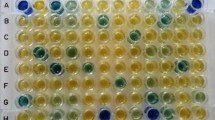Abstract.
Phytosiderophores of the mugineic acid family, and the respective iron species, have been separated by anion-exchange chromatography with NaOH gradient elution. Two different detection methods were used in parallel, pulsed amperometry (PAD) for phytosiderophores and atomic absorption spectrometry (AAS) for iron. This combination enables identification of separated iron species. Up to five different iron species were separated and detected within 30 min – two different phytosiderophore species, two amino acid species, and one species which has not yet been identified but which is most probably a decomposition product of phytosiderophores. The detection limit was in the low µmol L–1 concentration range, which is sufficiently low for determination in real plant samples, even after dilution. The method has been applied to root washings of iron-deficient wheat and barley plants and to a xylem exudate of non-deficient maize.
Similar content being viewed by others
Author information
Authors and Affiliations
Additional information
Electronic Publication
Rights and permissions
About this article
Cite this article
Weber, G., Neumann, G. & Römheld, V. Speciation of iron coordinated by phytosiderophores by use of HPLC with pulsed amperometric detection and AAS. Anal Bioanal Chem 373, 767–771 (2002). https://doi.org/10.1007/s00216-002-1302-2
Received:
Revised:
Accepted:
Published:
Issue Date:
DOI: https://doi.org/10.1007/s00216-002-1302-2




